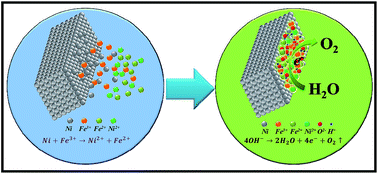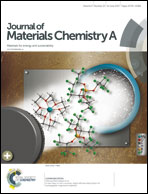In situ formation of highly active Ni–Fe based oxygen-evolving electrocatalysts via simple reactive dip-coating†
Abstract
Since the oxygen evolution reaction (OER) is a key step in the process of water splitting, efficient catalysts are inevitably required to overcome energy barriers at the electrode–electrolyte interface in order to improve its reaction efficiency; as a result, developing highly active and low-cost catalysts is of the great importance. Herein, we report an extremely simple method to prepare OER catalysts, which exhibit excellent activity and superior OER stability in alkaline conditions. The OER catalysts are composed of mixed Ni–Fe oxides or hydroxides that can be easily obtained by in situ reactive dip-coating of nickel foams in a Fe3+-containing aqueous solution. In specific, the as-prepared composites can give an overpotential value of 210 mV under a current density of 10 mA cm−2 in 1 M KOH aqueous solution and there is not any obvious degradation in OER activity even after 50 hour's chronopotentiometry measurement at a current density of 50 mA cm−2. More importantly, the samples prepared by this method also illustrate the good uniformity, in which this particular synthesis scheme would hold the great potency for practical fabrication of high-performance and low-cost catalysts in the large-scale industrialization.



 Please wait while we load your content...
Please wait while we load your content...